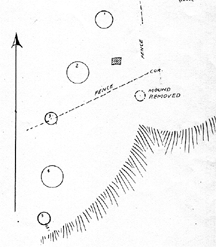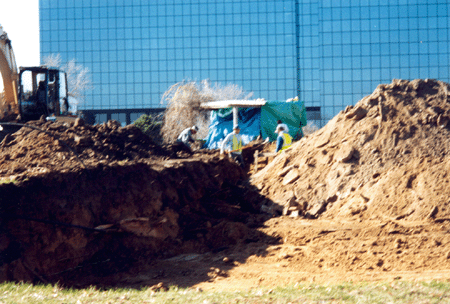
minnesotaHistory.net: a forum for discussing current events relating to the history of Minnesota
The Death of a Mound
Comments and Additions
November 16, 2004
The Lincoln Mounds as mapped in Newton Winchell's Aborigines of Minnesota, with Mound 1 at top, and Mound 5 at bottom:

November 3, 2004
The "authentication" continues at the Lincoln Mounds in Bloomington:

October 28, 2004
A report from the site of the mound in Bloomington: Heavy machinery is being used at the site in Bloomington, presumably as part of the archaeological survey, since the developer has not yet received approval for the development project.
October 24, 2004
A report from the site of the mound excavation in Bloomington: All the trees have been removed from the site. It looks like a tornado has been through. After the roots of the trees have been removed the archaeologists return to resume the survey.
October 22, 2004
As noted in the "The Death of a Mound," the excavation of the Bloomington mounds is taking place in a context in which Minnesota Indian tribes are nervous about the continuation of their exclusive right to operate casinos in Minnesota. Today the Minneapolis Star Tribune reports: Minnesota Governor Tim Pawlenty has announced that he wants Minnesota Indian tribes to pay $350 million a year to the state out of their gambling revenues. It is also suggested that Pawlenty is negotiating with a Las Vegas casino company to put a casino in Minnesota.
Octoober 21, 2004
A report from the site of the mound excavation in Bloomington: Trees are being cut down in the area around Mounds 1, 2, and 3 of the Lincoln Mounds. This indicates that the archaeological survey is continuing.
October 19, 2004
What is the historical evidence for the location of burials of Dakota people who died during the winter of 1862-63 at the Fort Snelling internment camps? Historian Corrine Marz, who has been doing research on the Fort Snelling camps, provides this information:
I have little documentation, only some possible suggestions, about what happened to the Dakota who died in the camp at Fort Snelling in the winter of 1862-63. Many of the Dakota who died then may have been buried at at Pilot Knob in Mendota. But other sites may have been selected as well. Good Star Woman, in her account in the book Through Dakota Eyes (page 263) said that a number of the people in the camp died of measles. Twenty to fifty people died in a day. She remembered that both the children and elderly were buried together in a long trench; the older people at the bottom of the trench with the children placed on top of them. She also recalled that of this trench or a second one, that a Roman Catholic priest brought a box for each body and put them in the trench until spring, �and then buried them right.�
For those buried at Pilot Knob or Mendota, wood caskets would have required a trip across the Minnesota by ferry with transport by wagon up the hill. If there were a hundred or more deaths, that would have taken great effort. It would not have been impossible, though. [Additional note: In the only known photograph of the camp, the river was frozen over and a dark track is evident in the ice where people crossed the river toward Mendota with wagons or other means.]
Another reference (which I only recall, but do not have) stated that the Dakota dead were buried in mass graves near the Fort. In the Army records, on the March 19, 1863 morning report, Lt. William McKusick, Indian Camp Superintendent, noted that the Dakota were moved up from the encampment because of flooding. There is no report that they returned to the fenced enclosure on the river prior to their May 1863 removal. One newspaper report placed the new encampment �about a mile from the Fort in the direction towards Bloomington.� The location would have been at least one third of the way to the Mall of America at the present Post Road location.
Also, because a number of the Dakota had been dug up and mutilated after burial, some were buried either permanently or temporarily, under the tipis within the Fort Snelling internment camp. It was a desperate action. They realized that secret burials might be essential. Once the ground was workable, Father Ravoux, possibly with the help of the missionaries Samuel or Gideon Pond, may have taken some of the caskets beyond where the Dakota were removed, to bury them in a secret and secure place. To safeguard this cemetery there would have been no fanfare or advertising of its location. The boxes would have been placed on wagons and taken up the road from the encampment, past the steamboat landing, and toward Post Road. Dakota may have come to assist in this effort. Ravoux and the other missionaries would not have anticipated the future development in the area. I suspect that there is a paper trail, but I have not found it yet.